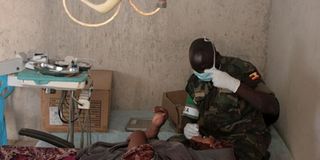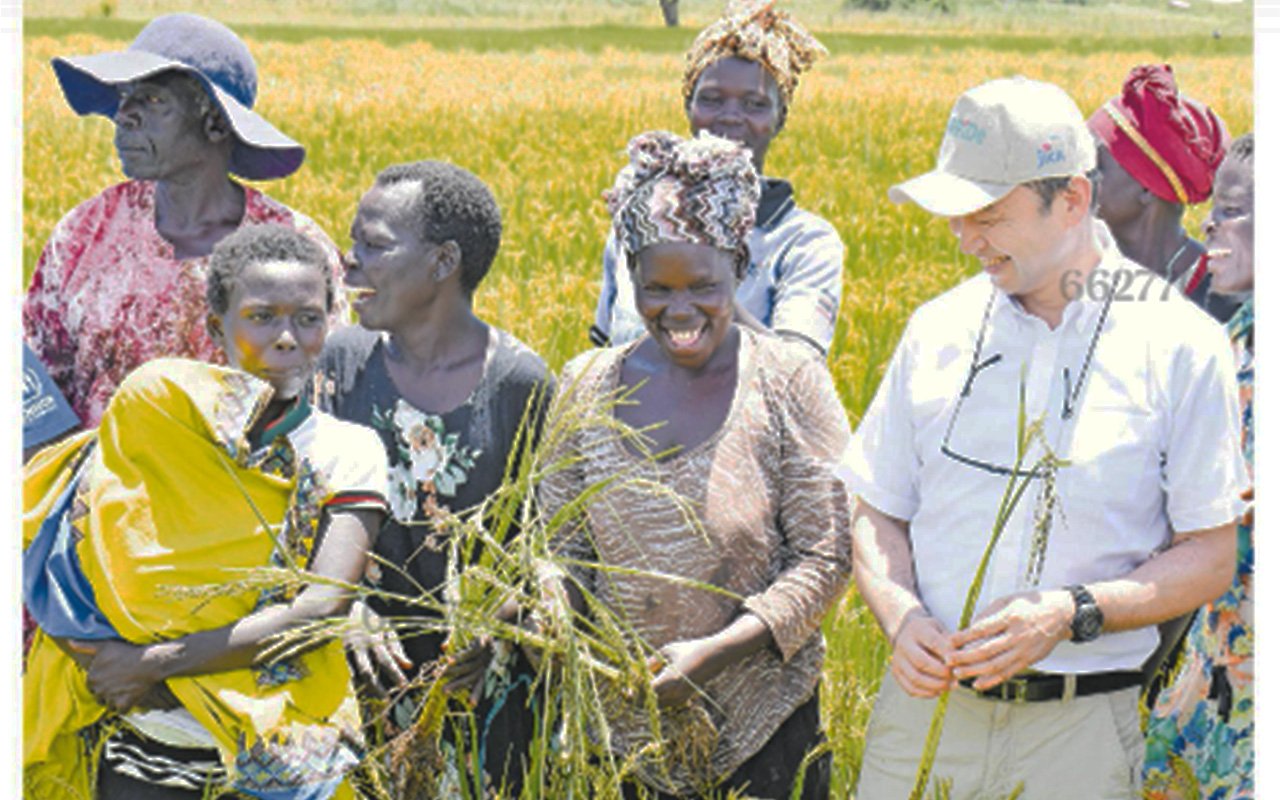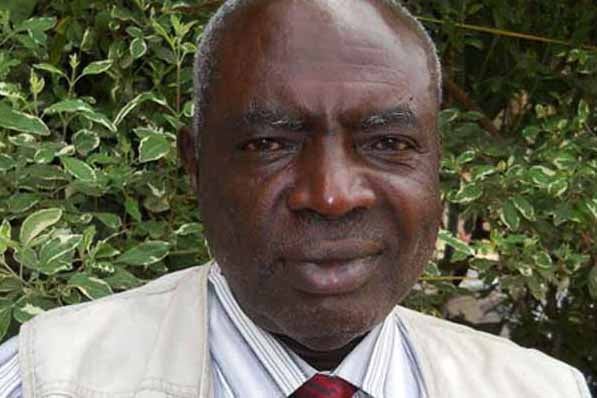Prime
Cry beloved Somalia: Five years of UPDF operations

A UPDF dentist extracts a tooth of a Somali resident at a hospital set up by the Force in Mogadishu. PHOTO BY JOHN NJOROGE.
What you need to know:
AMISOM’s mandate is to stabilise the security situation in Somalia. The UPDF have achieved quiet alot in the five years it has been in the war-ravaged nation.
Five years ago, the first UPDF battle group aboard a large Ilyushin Il-76 military transport plane landed in Mogadishu, Somalia’s capital city, for a peacekeeping mission.
The mission looked impossible because of the anarchy that followed the infamous black hawk down incident when 30,000 UN peacekeeping contingent was forced into a humiliating withdrawal. For the international community and UPDF specifically did not know whether this small African force would suffer the same fate but five years later the opinion on Somalia is different.
For more than 20 years, Somalia had degenerated into chaos and had become a dysfunctional state. Since 1993, every government that came into power was dogged by threats of external influence by militant organisations (al-Shabaab, Hizbul Islam, al-Qaeda) that wanted to use Somalia’s vast territories as a training ground for terrorists.
There is hope that sanity could be restored after Amisom forced the al-Qaeda-backed terror group, al-Shabaab, to flee the city. Semblance of normality has returned to the capital. Its once deserted streets are bustling with activity, homes, markets and schools are being rebuilt.
Residents can now venture to its beautiful beaches, once no-go zones, and take a dip into the warm waters of the Indian Ocean.
The Amisom spokesperson, Lt. Col. Paddy Ankunda says none of this was fathomable four years ago.
“In fact, on their first night in Mogadishu, the 400 Amisom troops, the first of two battalions promised by Uganda, had to endure mortar attacks from the extremists and relied on the protection of Ethiopian and Somali troops,” he says.
Over the course of the next three years, the force grew in strength but, though joined by troops from Burundi in December 2007, remained substantially below its authorised strength of 8,000.
The mission was also constrained by a restrictive interpretation of the rules of engagement which meant Amisom could only fire when fired upon or in defence of the transitional government established by Somalia’s decade-long peace process.
Following the withdrawal of Ethiopian forces in January 2009, Amisom which had given priority to the security of key installations in the capital, namely at the airport, seaport, presidential palace and later the strategic KM4 junction, increasingly became a target of extremist attacks.
A double suicide bombing in February left 11 dead and 15 injured. Another in September killed 17, including Deputy Force Commander, Brig. General Juvenal Niyoyunguruza.
In May, the extremists had launched an offensive to retake Mogadishu, pushing TFG forces back into Amisom-protected areas.
The Chief of Defence Forces, Gen. Aronda Nyakairima remembers those days: “We thought they were going to push us into the ocean,” he says.There followed years of indecisive battles as the extremists attempted to take control of the entire city and the TFG tried to recapture the areas it had lost. “We have driven out the government from the north of Mogadishu,” Sheik Ali Mohammed Rage, al-Shabaab’s spokesman, declared in May 2010. “Now our next step is to capture the palace.”
Due to intense attacks against the peacekeepers, the AU summit decided to amend rules of engagement to allow Amisom carry out pre-emptive strikes and also approved additional 2,000 forces.
After this deployment, Col. Ankunda says Amisom started a methodical advance across the city. “By mid-August 2010, half of the IGAD troops had been inserted into Mogadishu and, Amisom, now with more than 7,000 soldiers had established seven new positions in the south-western and southern part of Mogadishu,” he says
He says the Uganda Contingent opened up new positions at Immigration, Shakara, Telebunka, Sigale and Parliament.
“This action helped in effectively securing the key Makka Al Mukarama Road which is a main supply route and also links the Presidential Palace to K4 and Mogadishu airport,” he says.
Further east, he says Urubah Hotel in Shangani District, Bondere, Fish barre and Juba Hotel in Abdul Aziz District were also secured. Burundian forces controlled the Amisom bases in Hodan, Dharkenley, and Wadajir districts.
In late August, as the Islamic holy month of Ramadan got underway, the al-Shabaab launched what they called the “terminal offensive” declaring they would drive AMISOM out of Somalia and erase the TFG presence.
But Amisom and TFG forces beat back the attacks. “One company from the Burundi contingent, for example, deployed to Hoshi, which guards the south-western route into the city, in support of Transitional Federal Government troops there, who had come under attack from the al-Shabaab,” Col. Ankunda says.
The location was critical to securing the neighbourhood of Medina, and also served to extend the defences of the Mogadishu National University campus where Burundi contingent had its Headquarters.
By early September, Amisom held eight new positions previously under the control of armed opposition groups. By the end of 2010, the number of Amisom bases had nearly doubled, and now more than two dozen combat outposts dot the city map.
To date, the UPDF endures despite the heavy price it continues to pay. Estimates indicate the UPDF has lost over 100 troops in the five years of battle. Analysts have, however, put this number slightly higher than 300 troops. The failure of the offensive left the al-Shabaab severely weakened, having taken hundreds of casualties while achieving little in terms of strategic gains.
They amplified clan divisions and splits between the group’s nationalist and internationalist elements over command, the policy of denying access to humanitarian organisations trying to help the suffering population in Central and South Somalia, and the role of foreign fighters. Through the support of the IGAD reinforcements, the TFG had managed to gain ground and now controlled nearly half of the capital’s 16 districts.
But, with the limited number of troops, Amisom was unable to capitalise on this to push the extremists out of the city altogether. However, as the Amisom’s strength continued to grow, that day was now not far off.
“Amisom was keenly aware that insurgencies could not be defeated by purely military means and that the key to success lay in winning the support of the people of Mogadishu. With this in mind, its military operations increasingly adopted a humanitarian component,” Col. Ankunda says.
UPDF troops participating in this exercise are paid between $400 - $750 per month.
This is in addition to their monthly salaries back home. Of this $100 is given to them in Somalia while the rest is channeled to their bank accounts. According to the AU, these figures are set to increase. In the event of death while in battle, $50,000 is to be sent to the soldier’s next of kin as compensation.
The UPDF also receives between $100 and $120 per soldier participating in the mission. The UPDF consistently receives support for partner countries in form of weapons, money and training of its soldiers.
Medical treatment
The mission provides free medical care to more than 12,000 civilians every month and supplies over 120,000 litres of safe drinking water per week to Somalis living near Amisom camps.
Biggest battles
In early 2011, the TFG and its allies the Ahlu Sunna Waljamaa, a Sufi-based clan militia opposed to al-Shabaab, opened up a new front against the insurgents in the south-central regions of Gedo, Bakool and Lower Jubba on the Kenyan border.
This coincided with a renewed push in the capital by Amisom, whose mandated strength had now been raised to 12,000 by the UN Security Council.
The advance was designed to push the al-Shabaab out of the entire south-western section of the city, including Bakara Market, by far the largest commercial hub in Mogadishu.
The loss of the market was a mortal blow to the extremists since they depended on extortion from businesses there to fund their activities in the city.
The Amisom operations resulted in the Burundi contingent’s capture of the al-Shabaab’s main logistical and operational base located at the former Ministry of Defence building at Gashandigga, the former Milk Factory as well as the Damanyo Military Camp and the African Village, giving AMISOM full control of the Hodan district, Terebunka Road, and the western access routes into the market, and in the process inhibiting Al-Shabaab’s ability to reinforce its fighters from its base in Dayniile.
On the southern edge of the market, Amisom’s Ugandan contingent overrun al-Shabaab command positions on Wadnaha Road, a vital city artery, which had for a long time been closed to civilian traffic by the insurgents, who had dug trenches across it. It also completely secured Bondere District from where the extremists used to shell Villa Somalia, the seat of government.
The battle for Florenza was one of the fiercest in a long time. Heavy gunfire raged on for four days, the longest battle since the capture of Gashandiga.
Ugandan forces effectively cut off the Armed Forces road, leaving the market indefensible and exposing Mogadishu Stadium, the only remaining extremist stronghold.
Eight days later, on the morning of August 6, the al-Shabaab fled from most of Mogadishu. Pockets of extremists, however, remained in Deynille and to the North East of the capital from where they launched terror campaign against the population utilising suicide, vehicle and roadside bombs.
With al-Shabaab withdrawing from Mogadishu, it marks the beginning of the second phase of the mission which is spreading out of Mogadishu.
“Meanwhile, Somalia has been divided into sectors. Sector One will be controlled by the Ugandan contingent,” the commander of the Ugandan contingent, Brig. Paul Lokech says. “Sector Two is to be controlled by Burundians is the one along the Kenyan border of Kisimaya and Juba areas. Sector three is the areas of Baidoa.”
The question now though is for how long is the UPDF and Amisom going to hung in there in Somalia? Ugandans have already suffered the consequence of the UPDF’s presence in Somalia when twin suicide bombs went off in mid- 2010 killing more than 80 people who were watching the World Cup finals in Kampala.
Challenges
One the Amisom challenges remains lack of enough troops to spread outside Mogadishu and continuous political in-fighting in the Somali government that derails military successes.
Logistically, Brig. Lokech says there is need for force enablers; aircrafts, combat and field engineers, marine assets and other forms of logistics.




